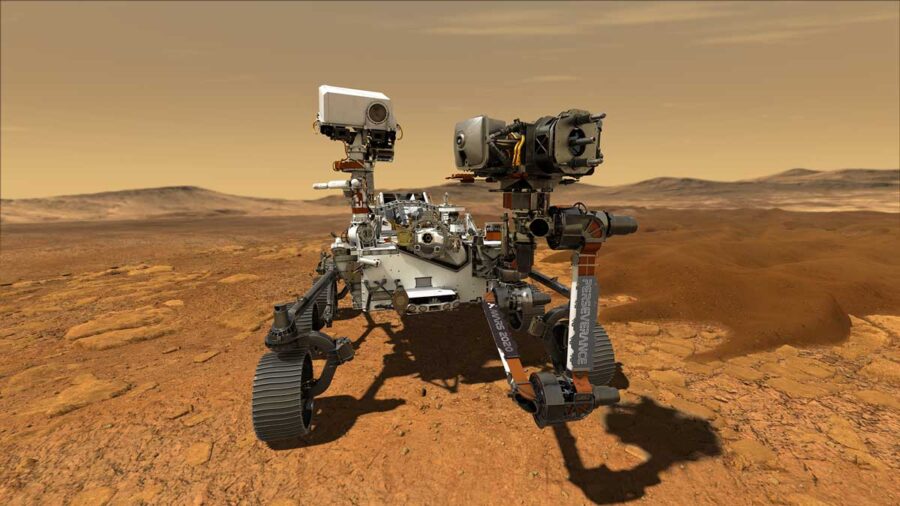Scientists Have Been Making Breathable Oxygen On Mars

NASA’s Perseverance rover has been exploring, collecting samples, and conducting experiments on Mars since 2021. Scientists have successfully generated breathable oxygen from the Red Planet’s very thin atmosphere thanks to a scientific instrument called MOXIE (Mars Oxygen In-Situ Resource Utilization Experiment).
MOXIE was included as part of Perseverance’s payload to test the feasibility of producing oxygen from Mars’ atmosphere. While the device has a long way to go before sustaining a colony, it has made impressive progress since 2021, producing approximately 122 grams of oxygen. This is roughly the amount of oxygen a small dog needs to breathe for ten hours.
“Developing technologies that let us use resources on the Moon and Mars is critical to build a long-term lunar presence, create a robust lunar economy, and allow us to support an initial human exploration campaign to Mars.”
Pam Melroy, NASA Deputy Administrator
Despite its relatively modest output, MOXIE’s accomplishments are extraordinary, considering its operating distance from Earth. In a statement, NASA Deputy Administrator Pam Melroy emphasized the importance of developing such technologies for future lunar and Mars missions.
“Developing technologies that let us use resources on the Moon and Mars is critical to build a long-term lunar presence, create a robust lunar economy, and allow us to support an initial human exploration campaign to Mars,” Melroy said in a statement about MOXIE via The Byte.
What makes MOXIE’s performance even more impressive is that it exceeded NASA’s expectations by generating twice as much oxygen per hour than initially anticipated. It also demonstrated its resilience by operating effectively on Mars for an entire year despite varying environmental conditions.
MOXIE’s ability to create breathable air out of the thin atmosphere of Mars is the first step towards supporting human exploration on the red planet.
MOXIE operates by using a complex electrochemical process to extract one oxygen atom from each carbon dioxide molecule present in the Mars atmosphere. This harvested oxygen can potentially serve multiple vital purposes for future astronauts. Primarily, it can be used as breathable air, addressing a fundamental requirement for human survival on Mars.

Additionally, this oxygen can be used to produce rocket propellant, significantly reducing the need to transport fuel from Earth for future missions to Mars. Interestingly, NASA’s plans continue beyond MOXIE’s current capabilities. Researchers are already looking to the next phase of the mission with MOXIE 2.0.
This improved version of the instrument aims to harvest oxygen and liquefy it for storage. The development of MOXIE 2.0 represents a significant step toward achieving the vision of astronauts “living off the land” on Mars. However, MOXIE’s principal investigator, Michael Hecht of MIT, is also eager to see other technologies prove their worth on Mars.
Another objective for Perseverance’s mission on Mars is astrobiology, which includes searching for signs of ancient microbial life.
Hecht expressed satisfaction with MOXIE being the first but believes other technologies should be considered for future Martian missions. Another objective for Perseverance’s mission on Mars is astrobiology, which includes searching for signs of ancient microbial life. The rover will analyze the planet’s geology and be the first to gather and cache Martian rock and regolith (broken rock dust).
In the subsequent stages of the mission, NASA, in collaboration with the European Space Agency (ESA), intends to dispatch spacecraft to Mars to retrieve these hermetically sealed samples for comprehensive analysis on Earth. The Jet Propulsion Laboratory (JPL), located in Pasadena, California, and managed by Caltech on behalf of NASA, is responsible for constructing and operating the Perseverance rover.
Furthermore, JPL oversees the MOXIE project as part of the Technology Demonstration Missions program within the Space Technology Mission Directorate (STMD). MOXIE’s development also received support from NASA’s Exploration Systems Development Mission Directorate and the Science Mission Directorate.










